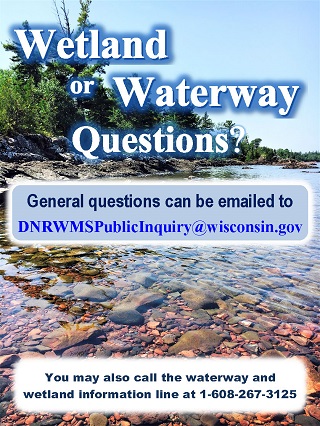Wetland Restoration
Wetland restoration is widespread practice in Wisconsin. Whether you are just getting started thinking about wetlands on your property, interested in enhancing waterfowl habitat, or looking to control reed canary grass or invasive cattails, the DNR and other partners can help you restore and manage your wetlands. Explore this page to find funding opportunities, restoration partners, and answers to FAQ like permitting options for restoration projects.
Map wetlands and wetland restoration potential on your property.
Read about wetland ecology and science.
Learn to identify and control wetland invasive species.
Explore wetland restoration for waterfowl.
Review wetland restoration permitting requirements.
Wetland General Permit Surcharge Fee Project Funding
The DNR Wetland Program is pleased to announce we are again accepting project proposals for the Annual Wetland GP Surcharge funding opportunity to help conserve, restore, or enhance wetlands in Wisconsin.
This announcement is a request for proposals for this year’s funding. The DNR will review proposals after this year’s application deadline of December 15, 2023.
An application form (3500-129) is available for stakeholders interested in applying for funding. If you are having problems opening the form, please visit PDF help.
Applications should be submitted by December 15, 2023 to Josh Brown. Potential applicants are encouraged to contact the DNR before applying. Selected projects will be notified by February 29, 2024.
Learn more about the program and completed projects on the Wetland GP Surcharge Restoration Program page.
WETLAND RESTORATION PLANNING
- Wetlands on Your Property
-
To find out if you have wetlands or wetland restoration potential on your property, visit the Property Lookup for Waterways and Wetlands page to learn how to view wetland maps on the DNR Surface Water Data Viewer. Also, the DNR and The Nature Conservancy developed the Wetlands by Design map tool for wetland restoration planning using a watershed and functional approach.
- Wetland Restoration Partners
-
The Wisconsin Wetlands Association, Ducks Unlimited, Wisconsin Waterfowl Association, and The Nature Conservancy are actively restoring wetlands in Wisconsin and may be a potential partner for your project. Visit their web pages for opportunities.
- Wetland Restoration Funding Sources
-
Visit the following pages for funding opportunities:
- Wetland Restoration Science and Design
-
Wetland restoration can involve improving wildlife habitat, restoring native plant species, increasing flood storage, improving water quality, or all of the above and more. Landowners can take any level of steps to restore a wetland, from controlling wetland invasive species to conducting a large-scale hydrologic and vegetative restoration. See wetland ecology and science for more resources to effectively restore native wetland communities.
- Wetland Plants and Invasive Species
-
Several wetland invasive species are widespread in Wisconsin, including Reed Canary Grass, Hybrid Cattail, and Phragmites. Establishing native plant communities in restored wetlands can be very challenging.
Additional invasive species resources:
- Planning for Climate Change
-
Global climate change complicates restoration targets and methods. To design your wetland restoration to account for Wisconsin-specific climate predictions, visit the Wisconsin Initiative on Climate Change Impacts (WICCI) website or review the Climate Adaptation Strategies and Approaches for Conservation and Management of Non-Forested Wetlands Menu.
- Wetland Restoration Handbook
-
This handbook lists the steps necessary to get started on restoring wetlands, starting with how to assess if restoration makes sense for the land. Planning and executing the project, understanding the environmental regulations and the people and programs that can help are all covered.
- Wetland Restoration - DNR Action Plan
-
This action plan explains some of the strategies DNR has used to increase wetland functional values on the landscape.

